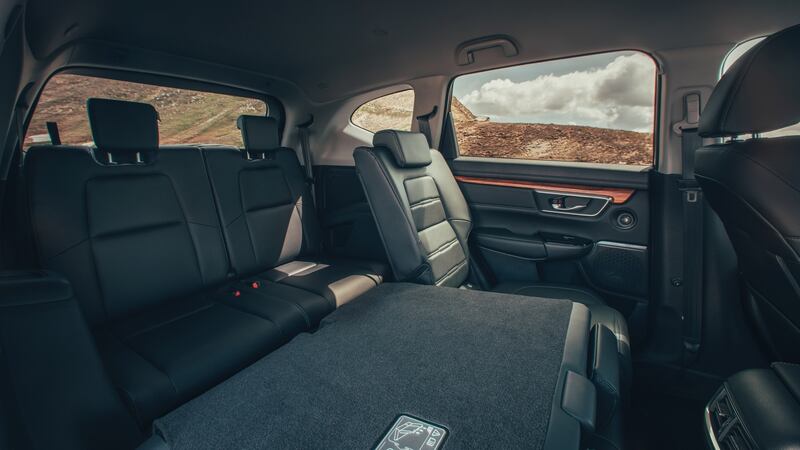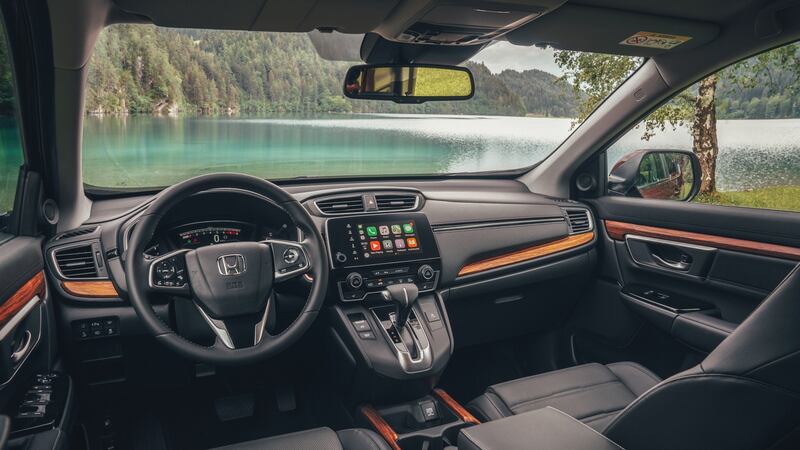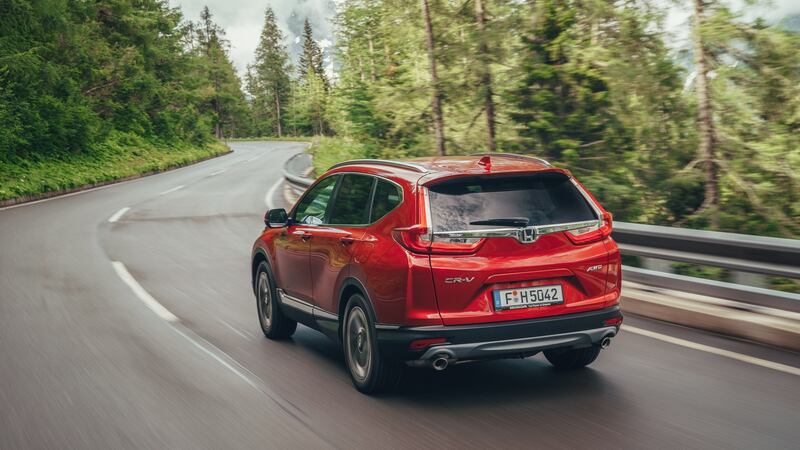If there has been one constant in the recent all-hogs-to-the-trough rush for SUVs, it's that the Honda CR-V is one of the very few such vehicles that pays more attention to the U-for-utility part of the acronym than others.
Since the second-generation model was launched in 2007, the CR-V has almost always been the roomiest and most practical of all mid-sized SUVs and crossovers, and that is surely the whole point. After all, if it’s the S-for-sport bit that you’re bothered about, then why are you actually buying an SUV in the first place? Utility is the name of the game here.
Diesel, though, is no longer in the game at all. As with Toyota’s RAV4, the new Honda CR-V won’t get a diesel version, and instead will be available only as a hybrid (which arrives in early 2019) and as a 1.5-litre turbo petrol, which we’ve had a chance to drive here.
It’s basically the same engine as you’ll find in the current Honda Civic, as indeed is the CR-V’s new platform and chassis. Although the CR-V stays exactly the same length overall as its predecessor, it has a wheelbase that’s 30mm longer, which has allowed Honda, for the first time in a CR-V, to give you the option of having seven seats.
Seven seater
These are not merely affectations of seats, either. Not just-there-for-the-decoration seats. In fact, Honda’s engineers have actually redesigned the 57-litre fuel tank for the seven-seat version, lowering it by 40mm to allow third-row passengers a touch more space for their feet.
In the seven seater, the middle row can be slid back and forth by 150mm (as well as folding flat and tumbling forwards) so with a little judicious juggling, you really can find adequate space for seven people, assuming at least two of them are still young enough to be fans of Voltron: Legendary Defender. The third-row seats are easily lifted into position by pulling a strap – you can do it one-handed without difficulty.

Go for the five-seat version and while the rear bench stays fixed in place, the legroom is positively limo-like, and thanks to the almost total absence of a transmission hump, those sitting in the centre rear seat have, for once, somewhere to put their feet.
That five-seat version has a very healthy 561-litre boot capacity (that shrinks, for the seven-seater, to just 150-litres with all seats up) so the CR-V is still more than hitting its marks when it comes to being the most practical car around.
Civic features
In the front of the cabin, the dashboard looks all but identical to that which you’ll find in the Civic, but Honda has had a good bash at making it look and feel a little more expensive, both in its choices of materials and the way they’re put together, as befits the CR-V’s more upmarket position. It more or less works – there’s more in the way of soft-touch surfaces, some nicely stitched leather, and on our test car some (very) fake wood that actually didn’t look too shabby.

The downside comes when you use both the instruments and the Honda Connect touchscreen. The unfortunate thing is that the main instrument pack looks cheap and is occasionally difficult to read (try working out how much fuel you have left), and the trip computer is awkwardly byzantine.
Meanwhile, the Honda Connect screen has the same confusing menu layout as the Civic, and some very cheap-looking graphics. Thankfully you can at least fix that by plugging in your Apple or Android phone and using the smartphone linking software instead. At least the cabin in the front is as practical as the rest of the car, with big door bins, and a massive central console storage area that can swallow either a laptop or a large bag.
The diesel debate
No diesel, though? Even with all the adverse diesel publicity, is that a wise move in the SUV market, especially considering that Honda’s 1.6 iDTEC diesel (still available in the Civic) is both one of the best diesel engines around, and one of the few which has never even had an official eyebrow raised in its direction when it comes to emissions and pollution?

It would be tempting to suggest that Honda is on a hiding to nothing here, but actually the 1.5-litre petrol turbo engine makes a far stronger case for itself than I would have thought possible. Generally speaking, the inevitable arithmetic of big SUV plus small petrol engine equals awful fuel economy is unavoidable, but somehow the CR-V seems to have sidestepped it.
You can choose from front-wheel drive or all-wheel drive versions with a manual gearbox, and a 173hp engine, or a CVT automatic version with all-wheel drive and 193hp.
It’s a very smooth engine, this, raising its voice a little under hard acceleration (and oddly sounding a little more vocal in the all-wheel drive models) but generally speaking proving very refined. The six-speed manual gearshift is a little long in the throw, but the CVT is actually the big surprise here – Honda says that it’s tried to make the gear-less gearbox mimic the feel of a conventional automatic and, aside from one or two full-acceleration moments, it does just that. It’s actually really pleasant to drive.
Handling
Fuel economy? We were driving on Austrian roads, near Salzburg, which are often more vertical than they are horizontal, but in spite of the gradients the 1.5 acquitted itself well. Most of the time we saw average fuel economy of about 8.2-to-7.5-litres per 100km (about 35-37mpg) and scored a best of the day reading, in a CVT all-wheel drive model, of 6.8-litres per 100km, or 41mpg, which is exactly what Honda claims you should get, on average. Impressive, especially when you feel how good the mid-range pickup of the engine is.
In handling terms, well you came here for the utility, remember? Honda makes a big deal of its Agile Handling Assistant (which tweaks the stability control as you drive to try to point the car where you want it to go) but really this is a car for cruising, not cornering. The steering feels artificial and mushy, and there’s quite a bit of body lean when pressing on. Much better to sit back into the very comfy seats, let the ride quality smoosh away the worst of the bumps, and revel in the CR-V’s excellent, refined, ground-covering capability.
While you might have to point out that it’s a new model to some people, and while we need to see Irish prices and specs (expect a circa 5-10 per cent rise in price) before we make a decision on how good/bad it is, there’s certainly no denying one thing: we’re not going to miss diesel half as much as we thought.
The lowdown: Honda CR-V 1.5 VTEC Turbo CVT AWD
Price: TBA but from approx €34,000.
Power: 193hp.
Torque: 243Nm.
0-100km/h: 9.3sec.
Top speed: 200km/h.
Claimed economy: 39.8mpg (7.1 litres/100km).
CO2 emissions: 162g/km.
Motor tax: €570.
Verdict: Still practical, still comfy, still pleasant to drive. Still want that diesel?











